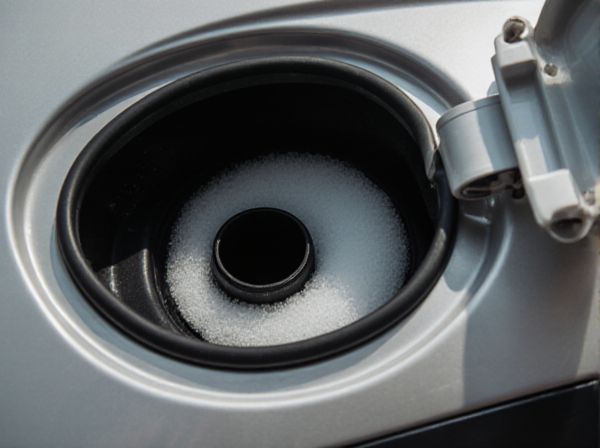
Photo illustration: Foam-filled Tank vs Open Space Tank
Foam-filled tanks offer superior structural support and minimize fluid movement, reducing the risk of sloshing and improving stability during transport. Open space tanks provide greater flexibility and volume capacity, but they are more prone to fluid dynamics that can affect balance and safety. Choosing the right option depends on your specific application requirements, including stability and capacity needs.
Table of Comparison
| Feature | Foam-filled Tank | Open Space Tank |
|---|---|---|
| Safety | Reduces explosion risk by suppressing fuel vapor | Higher risk of vapor ignition under impact |
| Weight | Increased weight due to foam material | Lighter overall weight |
| Fuel Capacity | Slightly reduced capacity by foam volume | Maximum fuel storage capacity |
| Cost | Higher manufacturing and maintenance cost | Lower production cost |
| Durability | Good resistance to sloshing and fuel vapor buildup | Potential sloshing issues, vapor accumulation |
| Usage | Common in aircraft and high-risk vehicles | Standard in most passenger cars |
Introduction to Fuel Tank Safety
Foam-filled tanks mitigate fire hazards by minimizing vapor space, reducing the risk of fuel vapor explosions compared to open space tanks. The foam structure limits fuel sloshing and vapor accumulation, enhancing safety in high-impact scenarios. Open space tanks, while simpler, pose greater risks due to uncontained vapors and potential for ignition during accidents or leaks.
What is a Foam-Filled Tank?
A foam-filled tank is a specialized storage container filled with polyurethane or similar foam to prevent liquid fuel from sloshing and reduce vapor space, enhancing safety by minimizing explosion risks. Unlike open space tanks, foam-filled tanks maintain stability under rough conditions and are commonly used in aviation, military, and fuel transport industries. The foam structure also limits fuel movement, improving tank durability and operational efficiency.
Understanding Open Space Tanks
Open space tanks store liquids with a vapor space above, allowing for thermal expansion and pressure adjustments, which is crucial for volatile or reactive substances. Unlike foam-filled tanks designed to minimize fire risks by reducing vapor space, open space tanks require careful venting systems and structural integrity to handle fluctuations in temperature and pressure. Proper maintenance and monitoring ensure the safe operation of open space tanks in industries such as petroleum refining and chemical processing.
Comparing Fire Suppression Capabilities
Foam-filled tanks provide enhanced fire suppression capabilities by rapidly smothering flames and preventing oxygen access, reducing the risk of explosions or reignition compared to open space tanks. Open space tanks rely on external suppression systems or manual intervention, which may delay fire control and increase hazards. The foam's insulating properties in foam-filled tanks also limit heat transfer, improving overall fire safety in storage environments.
Impact on Fuel Sloshing and Stability
Foam-filled tanks significantly reduce fuel sloshing by damping liquid movement, which enhances vehicle stability during acceleration, braking, and cornering. Open space tanks allow more fuel movement, increasing slosh dynamics that can disrupt balance and steering responsiveness. Incorporating foam structures optimizes internal fluid dynamics, maintaining consistent fuel delivery and improving overall control.
Maintenance and Longevity Considerations
Foam-filled tanks reduce internal surface corrosion and sludge accumulation, significantly lowering maintenance frequency compared to open space tanks. Open space tanks require routine cleaning and inspection to prevent rust and contamination, often resulting in higher operational costs over time. Foam-filled tanks typically offer enhanced longevity due to stabilized internal environments and minimized water ingress, extending service life by several years relative to traditional open space tanks.
Weight and Performance Differences
Foam-filled tanks offer significantly reduced weight compared to open space tanks due to the lightweight foam material that displaces heavier liquids, enhancing overall vehicle efficiency and handling. Performance-wise, foam-filled tanks minimize fuel sloshing, resulting in improved stability and consistent fuel delivery under dynamic driving conditions. Open space tanks, while typically heavier when full, provide greater flexibility for fuel volume adjustment and simpler maintenance compared to foam-filled alternatives.
Cost Comparison: Foam-Filled vs Open Space
Foam-filled tanks generally incur higher initial costs due to the price of foam materials and specialized manufacturing processes compared to open space tanks. Maintenance expenses for foam-filled tanks tend to be lower since the foam inhibits corrosion and reduces sloshing, which can extend tank lifespan and minimize repair needs. Open space tanks, while cheaper to produce initially, often face higher long-term costs from corrosion, fuel degradation, and increased risk of damage during transport or operation.
Application Suitability by Industry
Foam-filled tanks are highly suitable for industries requiring spill containment and fire suppression, such as chemical manufacturing and oil refining, due to their enhanced safety and structural stability. Open space tanks are preferred in industries like water treatment and agriculture where large-scale liquid storage with ease of access and inspection is critical. Selecting between these tank types depends on specific industry needs related to safety regulations, operational pressure, and maintenance requirements.
Conclusion: Choosing the Right Tank Type
Foam-filled tanks offer superior safety by minimizing explosion risks and reducing fuel sloshing, making them ideal for high-impact or accident-prone environments. Open space tanks provide greater fuel capacity and easier maintenance but require rigorous safety measures to prevent vapor buildup and ignition. Selecting the appropriate tank depends on balancing safety priorities, fuel efficiency needs, and operational conditions to ensure optimal performance and reliability.
 caratoz.com
caratoz.com